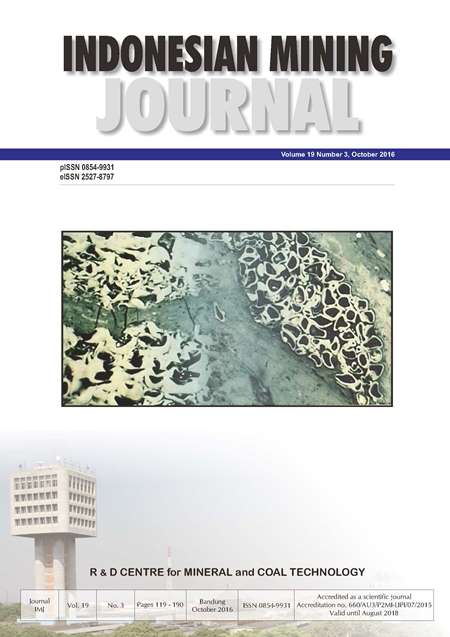POTENTIAL STUDY OF INDONESIA COAL FOR ADSORBED NATURAL GAS
DOI:
https://doi.org/10.30556/imj.Vol19.No3.2016.406Keywords:
activated carbon, adsorbed natural gas, surface area, iodine numberAbstract
Low rank coal was used as a precursor for the preparation of adsorbed natural gas by chemical activation with KOH-NaOH mixtures. Chemical activation process is commonly used and involves two major steps, which are heating process and chemical treatment process. The experiments were used in the various of temperatures, contact times, and rasio of sample and chemical compound. The result of process was obtained of the iodine number around of 1004 mg/g and 1198 mg/g . Based on the other study, the iodine number at 1004 mg/g and 1198 mg/g have surface area between 1000 mg/g up to 1200 mg/g. These surface area provide a methane capacity between 75 mg/g up to 80 mg/g.References
Abechi, S. E., C. E., G., A., U. and Y. A., D. (2013) “Preparation and Ccaracterization of activated carbon from palm kernel shell by chemical activation,” Research Journal of Chemical Sciences, 3(7), pp. 54–61.
Ahmed, M. J. and Theydan, S. K. (2012) “Physical and chemical characteristics of activated carbon prepared by pyrolysis of chemically treated date stones and its ability to adsorb organics,” Powder Technology, 229, pp. 237–245. doi: 10.1016/j.powtec.2012.06.043.
Ahmida, K., Darmoon, M., Al-Tohami, F., Erhayem, M. and Zidan, M. (2015) “Effect of Physical and Chemical Preparation on Characteristics of Activated Carbon from Agriculture Solid Waste and their Potential Application,” in International Institute of Chemical, Biological & Environmental Engineering June 5-6, 2015 Istanbul (Turkey). Istanbul (Turkey): International Institute of Chemical, Biological & Environmental Engineering, pp. 83–87. doi: 10.15242/IICBE.C0615015.
Biloé, S., Goetz, V. and Guillot, A. (2002) “Optimal design of an activated carbon for an adsorbed natural gas storage system,” Carbon, 40(8), pp. 1295–1308. doi: 10.1016/S0008-6223(01)00287-1.
Cheng, H.-M., Yang, Q.-H. and Liu, C. (2001) “Hydrogen storage in carbon nanotubes,” Carbon, 39(10), pp. 1447–1454. doi: 10.1016/S0008-6223(00)00306-7.
Code, K. R. and Provenzano, J. (2012) “Activated carbon associated with alkaline and akali iodida.” United State of America.
Gao, S. (2013) The research of adsorption model for methane/hydrogen and thermal effects on storage process. Jimei University of PRC.
González, J. F., Román, S., González-García, C. M., Nabais, J. M. V. and Ortiz, A. L. (2009) “Porosity development in activated carbons prepared from walnut shells by carbon dioxide or steam activation,” Industrial & Engineering Chemistry Research, 48(16), pp. 7474–7481. doi: 10.1021/ie801848x.
H., W. Z. and S., G. J. (1991) “Carbon Materials.” Shanghai: University of East-China Chemical Technology Press.
Hudaya, G. K., Sulistyohadi, F. and Monika, I. (2014) “Economic feasibility analyses of coal based activated carbon plant in Indoensia,” Indonesian Mining Journal, 17(1), pp. 1–9.
Jalil, A. H. (2012) “Surface area determination of activated carbons produced from waste tires using adsorption from solution,” Tikrit Journal of Pure Science, 17(2), pp. 99–104.
Joshi, S. and Pokharel, B. P. (2014) “Preparation and characterization of activated carbon from lapsi (Choerospondias axillaris) seed stone by chemical activation with potassium hydroxide,” Journal of the Institute of Engineering, 9(1), pp. 79–88. doi: 10.3126/jie.v9i1.10673.
Jüntgen, H., Knoblauch, K. and Zündorf, D. (1973) “Technische Erprobung von Aktivkoks aus Steinkohle für eine adsorptive Abgasentschwefelung mit integrierter thermischer Regeneration,” Chemie Ingenieur Technik, 45(19), pp. 1148–1151. doi: 10.1002/cite.330451903.
Loh, W. S., Rahman, K. A., Chakraborty, A., Saha, B. B., Choo, Y. S., Khoo, B. C. and Ng, K. C. (2010) “Improved isotherm data for adsorption of methane on activated carbons,” Journal of Chemical & Engineering Data, 55(8), pp. 2840–2847. doi: 10.1021/je901011c.
Menon, V. C. and Komarneni, S. (1998) “Porous adsorbents for vehicular natural gas storage,” Journal of Porous Materials, 5(1), pp. 43–58. doi: 10.1023/A:1009673830619.
Momen, G., Hermosilla, G., Michau, A., Pons, M., Firdaouss, M. and Hassouni, K. (2009) “Hydrogen storage in an activated carbon bed: Effect of energy release on storage capacity of the tank,” International Journal of Hydrogen Energy, 34(9), pp. 3799–3809. doi: 10.1016/j.ijhydene.2009.03.011.
Monika, I. and Suprapto, S. (2009) “Pengaruh kadar abu semikokas terhadap mutu karbon aktif dari batubara,” in Prosiding Seminar Nasional Teknik Mesin 4. Surabaya: Universitas Kristen Petra Surabaya.
Nowicki, P., Kazmierczak, J. and Pietrzak, R. (2015) “Comparison of physicochemical and sorption properties of activated carbons prepared by physical and chemical activation of cherry stones,” Powder Technology, 269, pp. 312–319. doi: 10.1016/j.powtec.2014.09.023.
Nunes, C. A. and Guerreiro, M. C. (2011) “Estimation of surface area and pore volume of activated carbons by methylene blue and iodine numbers,” Química Nova, 34(3), pp. 472–476. doi: 10.1590/S0100-40422011000300020.
Pragya, P., Sripal, S. and Maheshkumar, Y. (2013) “Preparation and study of properties of activated carbon produced from agricultural and industrial waste shells,” Research Journal of Chemical Sciences, 3(12), pp. 12–15.
Raðenoviæ, A. (2006) “Pyrolisys of coal,” Piroliza ugljena, Kem. Ind., 55(7–8), pp. 311–319.
Sahoo, S. and Ramgopal, M. (2014) “A simple regression equation for predicting charge characteristics of adsorbed natural gas storage systems,” Applied Thermal Engineering, 73(1), pp. 1095–1102. doi: 10.1016/j.applthermaleng.2014.08.031.
Sekirifa, M. L., Hadj-Mahammed, M., Pallier, S., Baameur, L., Richard, D. and Al-Dujaili, A. H. (2013) “Preparation and characterization of an activated carbon from a date stones variety by physical activation with carbon dioxide,” Journal of Analytical and Applied Pyrolysis, 99, pp. 155–160. doi: 10.1016/j.jaap.2012.10.007.
Sihite, T. (2012) Low rank utilization in Indonesia. Tokyo.
Sudaryanto, Y., Hartono, S. B., Irawaty, W., Hindarso, H. and Ismadji, S. (2006) “High surface area activated carbon prepared from cassava peel by chemical activation,” Bioresource Technology, 97(5), pp. 734–739. doi: 10.1016/j.biortech.2005.04.029.
Vasiliev, L. L., Kanonchik, L. E., Kulakov, A. G., Mishkinis, D. A., Safonova, A. M. and Luneva, N. K. (2006) “Activated carbon fiber composites for ammonia, methane and hydrogen adsorption,” International Journal of Low-Carbon Technologies, 1(2), pp. 95–111. doi: 10.1093/ijlct/1.2.95.
Yahia, S. Ben and Ouederni, A. (2012) “Hydrocarbons gas storage on activated carbons,” International Journal of Chemical Engineering and Applications, 3(3), pp. 220–227. doi: 10.7763/IJCEA.2012.V3.190.
Downloads
Published
Issue
Section
License
Indonesian Mining Journal provides immediate open access to its content on the principle that making research freely available to the public to supports a greater global exchange of knowledge.

This work is licensed under a Creative Commons Attribution-NonCommercial 4.0 International License.













